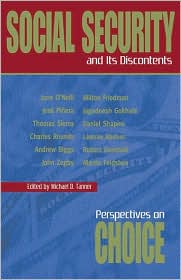

Social Security Historical Calculator |
Hosted by Granite Tower | |
|
you got social security but that dont pay the bills - Jewel Kircher |
||
|
To rely on tax increases to fund the shortfall in Social Security
is to commit future workers to paying more than 18 percent of their wages to cover
the benefits of retirees in another 18 years, and 25 percent of
wages to cover benefits at mid-century. - June O'Neill, former director, CBO |
||
House Bill H.R.4895, introduced by Sam Johnson, Jeff Flake , and Pat Toomey , provides you and me with an option to invest our portion of the FICA/OASDI taxes to be invested in a private account. Use this calculator to determine what your account would have been worth if this bill had been in effect in previous years. The calculator goes back 30 years to 1974. HR4895 provides choice only to individuals born after 1950.Several plans are on the floor in both the house and the senate. HR4895 has two distinguishing features that makes it superior: The level of contribution in the Flake-Johnson plan is higher than many of the others, and HR4895 is the only plan that includes recognition bonds. | ||
|
1974:
1975: 1976: 1977: 1978: 1979: 1980: 1981: 1982: 1983: 1984: 1985: 1986: 1987: 1988: 1989: 1990: 1991: 1992: 1993: 1994: 1995: 1996: 1997: 1998: 1999: 2000: 2001: 2002: 2003: 2004: 2005: |
In the Social Security debate, Social Security Choice is a better term than Social Security Privatization, since the former term more accurately describes the idea. HR4895 wants to give workers the choice to invest their retirement funds in the private capital markets. This page refers to that reform idea as Social Security Choice.
Choice opponents have argued that Social Security has a flat tire, and all we need to do is fix it and move on. This analogy has been attributed to Robert MenÚndez, but more likely originates with Peter Orszag from Brookings. You wouldn't replace your car for a flat, but surely you would if it got totaled; Social Security is headed in that direction. Not only that, but it was a Yugo to begin with. While it's going into the ditch, a brand new Porsche is sitting on the shoulder, key in ignition and engine humming, waiting for you to get behind the wheel and take off.
If you compare the calculated portfolio with your current Social Security statement, it is important to keep a couple of things in mind. With the current Social Security system, once you've cleared the minimum threshold to receive benefits, your monthly allowance will not go up that much even as you continue working. Conversely, under Social Security Choice, as you keep earning a salary, your portfolio will continue to increase, both from return on your investments as well as your continued contributions.
Additionally, scheduled Social Security payments are not
sustainable. The Supreme Court has
ruled
that you do not have an intrinsic right to Social Security.
Alternate proposals to save Social Security calls for either
raising taxes, raising the retirement age, or reducing benefits.
The
Brookings plan, for instance, proposes a combination of all three.
The authors concede the worse deal this proposal yields:
"For younger workers with average earnings, our proposal does
lower benefits relative to those scheduled under current law, with
the reductions smaller for older cohorts than for younger ones. "
This is even before taking into account the rising retirement age
under that proposal. Similar steps have been taken before;
the original Social Security tax was just 2%, vs 12.4% today.
See also
Saving Social Security is not Enough.
For financing the transition, see Facts and Fantasies about Transition Costs.
As a final note, under HR4895, all current retirees -- in fact, everyone born before 1950 -- will continue to receive promised benefits . This will be financed by the employers 6.2% OASDI contribution.
| The informative, educational, analytical, sensible, erudite version: | |
Social Security and Its Discontents: Perspectives on Choice
|
|
| The misguided head-in-the-sand, pretend there is no problem, cross-your-fingers-and-pray-to-the-fairies version: | |
Social Security: The Phony Crisis
|
|
Yahoo Finance --
The data for the calculations comes from this site.
SocialSecurity.org -- Cato's Social Security website
SocialSecurity Calculator -- use this to calculate
future projections of your return
Social Security Choice -- lots
of good links to news and comments
For Our Grandchildren -- a good
site for introductory information and news on Social Security in general, reform
in particular.
The 6.2 Percent Solution, by Michael Tanner. Many of the ideas in
HR4895 comes from Tanner's proposal.
Brookings Project: Retirement Savings
The Brookings Institute's project on Retirement Saving.
Comment: Brookings is against Social Security choice, but in assessing the retirement issue,
they advocate ways to make workers save more for their retirement. It is unclear why they don't want
to increase savings through Social Security reform.
Econlib.org article
Encyclopedia of Economics, a great site chock full of data.
House of Representatives It is easy to look up your representative and write
a short note to her or him.
Thomas -- Legislation Database Use this to look up bill hr4895 (I haven't found a way to link to
it directly).
Opposing View by Leiter, citing a Nation
article by Dean Baker. Also see my email to Leiter.
Roger
Hanson op-ed (pdf). "As a lifelong Democrat, I
am concerned that the Establishment Democratic Party in Washington has allowed
partisanship to eclipse its good sense of policy."
Centrists.org
Conference Transcript -- Representations and Q&A with Lindsey Graham,
Republican Senator, and Harold Ford, Democratic Representative.
RetireSafe.org
Team NCPA -- see their Calculators page.
Social Security Chronology --
Detailed historical information on public retirement plans in the US. For
details on the Social Security Bill, see the 1930s decade. For
historical information on the Supreme Court rulings regarding Social Security,
see this interesting narrative
.
Email me with comments.